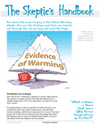|
|
Too much panic is never enough. Fran Kelly asks Stephen O’Brien, lawyer and UN official, about that the effects of climate change which are “already being felt”. She does not blink when his answer includes more frequent and more severe tsunamis. His qualifier… It’s not a question of “if”, but “when”.
Yes, yes, this is “best and brightest” ideas from around the world, apparently.
ABC Radio National
Fran Kelly: “Give us a sense of the effects [of climate change] which are already being felt in our region and discussed at this conference.” (at 1 minute)
Stephen O’Brien: “The Pacific Region, and particularly the Pacific Island countries whose land, as you rightly say, are the ones just above sea-level, are the ones that really do have the greatest challenge when it comes to climate change effects on humanitarian need, with the regularity of cyclones, tropical storms, and tsunamis coming through [at 1.30 minutes]. It’s not a question of if, it’s a question of when. And we see that [these] effects of climate change seem to be exacerbated so that they are more frequent and even at times more severe…”
ABC gives free advertising for “the cause” […]
Yet more evidence that there is no relationship between CO2 and cyclones, hurricanes, and typhoons. This paper from 2012 tests the theory that global warming made storms more severe and tried to find any effect on typhoons hitting Japan that could be linked to climate change since 1980.
There has been no increase in “super typhoons”. The typhoon season is not longer, nor is it delayed in starting. There has been no change in intensity. The wind speeds are not increasing. The minimum pressure is pretty much the same.
CO2 appears to influence storms in simulated worlds, but not so much in the real one. There is no sign of more severe storms in Australia, New Zealand or the South Pacific either. Nor is there any pattern in the Global Energy indicies, US Hurricanes, US Tornadoes either.
When will scientists and reporters make sure that their audiences know that?
The authors conclude:
“The results suggest that typhoons have not been influenced by global warming. In conclusion, global warming has not significantly changed the characteristics of typhoons, and there is no close relationship between the two.”
Figure 19. Number of super typhoons that develop
9.4 […]
So far 24 are confirmed dead in Vanuatu, a figure that seems likely to rise. About 100,000 are homeless, according to the local Oxfam director, which, if accurate, is an awful lot in a country of 270,000. There is no doubt the nation needs help.
Despite the pressing need to solve immediate problems, the predictable claims are already starting. How many journalists will bother to check these claims against the history of cyclones in Vanuatu? Accuweather lists a lot, including one in 1951 that killed 100 people when CO2 levels were just 311ppm. In 1987 another storm killed 48.
President Baldwin Lonsdale is blaming “climate change”.
Pacific nations regard themselves as at the frontline of climate change, given many are low-lying islands dangerously exposed to rising sea levels, and Lonsdale said changing weather patterns were partly to blame for the destruction.
“Climate change is contributing to the disaster in Vanuatu,” Lonsdale told reporters in Japan, saying rain had been unusually heavy this year.
Even President Hollande, host of the Paris UNFCCC later this year, is milking this disaster: “…the cyclone “is a new cry for the international community to take seriously its responsibility in the fight […]
UPDATE: Data for Middle Percy Island has disappeared from the BOM site, but Jennifer Marohasy kept a copy. (I’m sure the BOM will be grateful!) The Courier Mail has an article quoting Jennifer.
The facts on Cyclone Marcia: the top sustained wind speed was 156 km and the strongest gust 208 km/hr. These were recorded on Middle Percy Island in the direct path before it hit land and apparently rapidly slowed. The minimum pressure recorded after landfall was 975Hpa. BOM and the media reported a “Cat-5” cyclone with winds of 295 km/hr. To qualify as a Cat 5, windspeeds need be over 280km/hr. The UN GDACS alerts page estimated the cyclone as a Cat 3.
The damage toll so far is no deaths (the most important thing), but 1,500 houses were damaged and 100 families left homeless. It was a compact storm, meaning windspeeds drop away quickly with every kilometer from the eye, so the maps and locations of the storm and the instruments matter. See the maps below — the eye did pass over some met-sites, but made landfall on an unpopulated beach with no wind instruments. It slowed quickly thereafter. The 295 km/hr wind speed was […]
Get ready:
“Australia records its third quietest start to the cyclone season in 50 years.” ABC news, Jack Kerr
Bravo, I thought. ABC covers a good-weather story… but no, lo, for the climate oracles tell us this is ominous and bigger nastier storms are coming. Be afraid!
This weather is weird?
There have only been four occasions since the mid-1960s when cyclones haven’t crossed the mainland before February.
Only four. Golly! This year is almost as “bad”as the worst of the prehistoric era, i.e. ’68, ’80, ’88).
It’s not like the good ol’ days — when people used to get decent cyclones all the time:
Back in 1870, when Cairns started life as a gold port, four to five severe cyclones would hit the Queensland east coast every decade. By 2010, that average was down to less than two.
Lucky them.
To see the effect of man-made global warming, look hard at this graph below. Spot the… trend.
A high bar means a long slow quiet start to the cyclone season.
At the start in 1964 CO2 was a wonderful 320ppm. Now it is at 400ppm and obviously (when seen through a computer […]
UPDATE Sat morning: Thank goodness this has slowed dramatically. Now Cat 1 at 120 km/hr. 990hPa. While some have lost homes, there don’t seem to be any lives lost, though rainfall and storm surges mean the situation is still dangerous. Courier Mail appears to have the best live coverage.
About midnight, last night Queensland time, Cyclone Ita crossed the coast. (Roughly about now). Hopefully it will pass through a less developed region. It potentially could be disastrous. We hope not. It is about 500km across (?) while Cyclone Yasi was 600km wide. Winds were nearly 300km per hour but have slowed to 265km/h 205km/h. One meteorologist predicts it to slow to Category Four as it makes landfall. [He was so right, it’s now a Cat 3]. Other reports say there’s no sign of that.
…
Cyclone Ita is currently Category 5 Category 4 Category 1 bearing down on the region around Cooktown and Cairns in North Queensland.
The Cairns 500km radars show it. The BOM warnings. ( 120km 105 30km N of Cooktown. Winds: 295km/hr. 265km/hr 205km/h Pressure: 931 939 960hPa. ) It’s clearly visible in the satellite image on the radar link. ABC live blog. […]
UPDATE: Cyclone Ita is now Category 5 bearing down on Cooktown in North Queensland, the radars will show it soon. 175km NNE of Cooktown. Winds up to 300km /hr. 931 hPa. See The BOM warnings. Thoughts for those in the path. (It’s clearly visible in the satellite image on the radar link).
——————————————————————————–
A new paper by Andrew Dowdy tells us that from 1980 to 2013 the incidence of tropical cyclones around Australia has been falling. If CO2 is influencing cyclones around Australia, presumably this implies we should burn more coal.
Those convinced about the power of CO2 will point out that the models predict an increase in intensity, not frequency. To that end, I say: see the BOM graph below. Note the red bars marked “severe”. Then tell yourself that the science is settled and we should spend billions to change those trends. The BOM say “the number of severe tropical cyclones (minimum central pressure less than 970 hPa) shows no clear trend over the past 40 years.”
Interestingly Callaghan et al 2010 goes back all the way to 1870. It finds the trend of severe land-falling cyclones has fallen by a whopping […]
A new high resolution ice core in Greenland surprises even me with the wild swings and detail. The authors are discussing wind direction and storms that occurred in specific years 12,000 years ago, which is extraordinary information if accurate. They use elements like sodium (from sea salt) to figure out how many storms have dumped salt on the ice and take bands so thin they identify each summer so long ago*. The slices are so thin, they claim to have hundreds of samples per year.
The message here is that the cold younger dryas period ended abruptly (within one year) and so did the storms. Naturally, they warn that the abrupt changes mean the climate is unstable, “be afraid” type stuff. My take on this is that if natural factors cause abrupt climate change, we need to know what those natural factors are. The obsession with CO2 is hindering that. Also if warming brings less storms, that’s probably not such a bad thing. The caveats being that this is only one site, and less storms over the GISP site doesn’t tell us if less storms occurred elsewhere. It could be that jet streams shifted and moved the storms to another […]
These days people are practically getting post traumatic climate disorder after bouts of extreme weather. More pointlessly, some are getting pre-traumatic stress from events that haven’t even happened.
Makes you wonder how humanity survived the ice ages every time a storm hit — no fire department, no Hurricane-Relief funds, no phones, no food stores, no doctors. Electricity out for 90,000 years.
Americans’ Mental Health is Latest Victim of Changing Climate (Op-Ed)
For months after Hurricane Sandy sent nearly six feet of water surging into her home in Long Beach, N.Y. — an oceanfront city along Long Island’ s south shore — retired art teacher Marcia Bard Isman woke up many mornings feeling anxious and nauseated. She had headaches, and inexplicable bouts of sadness. She found herself crying for no apparent reason.
“I would feel really sad, and that’s just not me,” she said. “I felt like the joy was out of my life. I still haven’t recaptured it.”
What Isman is experiencing is one of the little-recognized consequences of climate change, the mental anguish experienced by survivors in the aftermath of extreme and sometimes violent weather and other natural disasters. The emotional toll of global warming is expected […]
A new paper suggests there is an “unprecedentedly” low number of tropical cyclones around Australia at the moment. (How much should we spend to avoid this dreadful outcome I wonder?)
I am a little skeptical of how we can be so sure of the cyclone activity in, say, the year 900 AD. But nonetheless, the study is worth a look. Haig et al took stalagmites from two places in Australia (Chillagoe, Qld, and Cape Range, WA) and got very nice long year-by-year records of 18O and 16O data. They calibrated these against observational instrumental records — though I note these are but a tiny 20 years of data (1990 – 2010), and that during a period described by mainstream climate science (cough) as “unprecedented”.
Assuming that it is possible to pick apart normal rain and cyclonic rain, and that cyclone activity did not just shift to be more than 400 km away (where these stalagmites won’t record the cyclones) then it does appear that there are usually more cyclones in Australia than now. Note the top graphs are the WA site which go back to 500AD, and the lower pair are the QLD graphs “only” going back to 1300AD. Both […]
Another round of government-funded PR went out a couple of weeks ago, across the obedient Pravda-media. It told us about another meaningless “record” that was probably not a record, and wouldn’t tell us whether man-made warming was the cause, even if it was. Not a single journalist had the wherewithal, nous or intellectual honesty to search the Internet looking for a different point of view. Though, in their defense, how could they have guessed that Prof David Karoly wouldn’t know about the UAH satellite program to measure temperatures? (It has only been running since 1979.)
This below, are the 12 month averages over Australia by satellite. Graphed at Kens Kingdom by Ken Stewart, with no doctorate in climatology and no government funds.
In the troposphere over Australia it was a hot year but not a record.
For the third time this year we’ve been hit with claims of a “hottest ever” record that doesn’t tell us anything about the climate, but does reveal a lot about the sick state of government funded science, corrupted, decrepit, and so far from being scientific it might as well be run by Greenpeace. If the government stopped funding climate science entirely, climate […]
Stephan Lewandowsky’s work is a case study in government funded inanity. Some Australians are sure that burning coal will make storms stronger. Others are not convinced. In November 2012 Lewandowsky’s intellectual contribution to science in Australia was to call the unconvinced “stupid”. If that’s not inane enough, at the same time he claimed that he didn’t recieve funding from any organisation that would benefit from his article.
How many taxpayer dollars went towards funding that? No conflict of interest?
Are Australian Research Council funds used as a form of third party advertising for Labor Government policy?
Writing in “A storm of Stupidity, Sandy, Evidence and Climate Change” on The Conversation, his reasoning is like this: some scientists reckon that a very bad storm called “Sandy” has “links” to man-made emissions of a trace gas. Lewandowsky reasons that because those scientists are called “experts”, anyone who questions them should be called stupid. (He thinks this article and that tweet were overdue). Though, in a twist, apparently he doesn’t actually think the unconvinced are actually stupid, he thinks they are ethically “disembodied” people who “mislead”. (As an aside, notice how he approves of news articles that call them stupid even though […]
Get ready — for all the fears of extreme weather coming our way — studies of Queensland, Victoria, the whole of SE Australia, New Zealand, and Perth show that either nothing is changing (there have always been bad storms) or possibly, the weather is better now than it used to be. Where is the evidence to support the claims by alarmists that increasing CO2 will make “extreme weather” more common? It’s less windy now across South East Australia than it was in the 1920’s. It’s less stormy on the southern coast of Victoria, and records that go back 7000 years in New Zealand and 5000 years in Queensland show repeated examples of monster storms that — should they hit today, would be described as being “likely” due to coal fired power stations and excessive use of SUV’s.
The Science and Public Policy Institute published Historical storm trends in Australia and New Zealand in June. This post builds on that publication.
…
It’s less windy across South East Australia
Alexander et al 2011 looked at locations from Port Lincoln (SA) to Goondiwindi (QLD), to Hobart (Tas) which pretty much covers everything anyone could call South East Australia. They used wind […]
Catastrophic killer storms are coming!
‘The Australian Greens say Tropical Cyclone Yasi is a “tragedy of climate change”.’
“DESTRUCTIVE hurricanes such as Katrina and Rita are likely to be more common … Tim Flannery warns.” “These hurricanes have been a catastrophe just waiting to happen.”
…
The IPCC concludes:
“Studies showed … future tropical cyclones would likely become more severe with greater wind speeds and more intense precipitation.” AR4 10.3.6.3 Tropical Cyclones (Hurricanes) pp786
…
Wow, that’s scary! Let’s look at the studies:
“These studies fall into two categories: those with model grid resolutions that only roughly represent some aspects of individual tropical cyclones, and those with model grids of sufficient resolution to reasonably simulate individual tropical cyclones.”
Oh? That’s models, or er… other models?
But where are the observations?
CO2 levels have risen to the highest level in a million years, presumably Hurricanes, Tornadoes and Cyclones are at all time highs, stronger and nastier than […]
Yasi — the super cyclone that isn’t so unusual
Random shot of some coral bits on a beach.
For all the other Christine Milne’s out there, who think coal mining causes cyclones, the empirical evidence inconveniently declares that super-cyclones have been hitting Queensland regularly for the last 5000 years.
As usual, it’s the name-callers who cling to 100 year time-frames and deny the long term evidence, while we “cherry-picking denialists” gravitate towards long term studies based on real observations. (The evidence lies in an obscure industry newsletter called Nature.) The way researcher, Jon Nott, describes it, things have been unusually quiet in our high CO2 world for the last few decades, but cyclones used to be a lot worse, and “worse” is coming back.
Thanks to The Australian for putting together a very timely piece about the historical pattern of cyclone activity.
[Johnathon] Nott is an expert on the incidence of super cyclones. By analysing ridges of broken coral pushed ashore by storm surges, he has catalogued the incidence of super-cyclones over the past 5000 years.
In a paper published in the scientific journal, Nature in 2001 his research shows the frequency of super-cyclones is an order of magnitude […]
File this under shock and awe. Send best wishes to North Queensland.
Cyclone Yasi is now Category 4 Category 5, with windspeeds of 270 295 km per hour (185 miles/hr).
UPDATE #2: Yes, thousands are evacuating, or moving to higher ground. Extra flights and trains are taking people out. Hospital patients are being moved. People are boarding and taping up windows. Whole suburbs in danger of inundation are being evacuated. It’s about 12 hours to go.
Infra red imaging of North Queensland and Yasi
I do a double take each time I see just how far Yasi reaches.
It reminds us of our relative power. It’s 3000 km (1620 nautical miles) from Melbourne to Cape York (roughly the most southerly point on continental Australia to the most northerly) . The full spread of the cloud formations connected to Yasi is a similar scale.
10 out of 10 based on 2 ratings […]
FINAL UPDATE: The far southwest cyclone is just… drizzle. Best wishes for the Queenslanders who are dealing with the real thing right now.
UPDATE#3: Sunday morning –The Cyclone is now Category 1, and wind speeds only 100km/hr and falling, so the BOM have turned off the CYCLONE Alert, and now call it a “Low”. Their map suggests whatever’s left will have a direct hit on perth, but the infra red image suggests it’s already gone past… and will just clip the lower corner of the state. Looks like it will just be a stormy day.
UPDATE #2: Saturday night —This glorious NASA image shows Bianca a few days ago. Right now the cyclone is losing strength over the cooler water as it heads towards the West Australian Southern coast. Windspeeds have dropped from 185km/hr to 140km/hr. But I thought the intricate detail in this photo was magnificent.
Cyclone Bianca tracks towards SW Western Australia. (Click on the image to go to the BOM page to watch the hourly updates of satelite images.)
Cyclone Bianca off the North West Cape 27 – Jan – 2011 Image: NASA, Modis 1 pixel = 1 km.
With wild blizzards in the Northern […]
Will a hotter world lead to more intense storms?
2010 might be on track to be the warmest ever (according to GISS), but right now, we may be about to set a new record of tropical storms — in inactivity. Ryan Maue tracks the global accumulated activity and reports that by the end of July we might break the record low we set last year.
Ryan N. Maue’s 2010 Global Tropical Cyclone Activity Update
July 15: If no additional ACE occurred in July, the 24-month global ACE total would be 1095 compared to last month at 1173. The previous 30-year low was 1091 set recently in September 2009. No lower values exist during the past 30-years.
Global and Northern Hemsiphere Tropical Cyclone Activity is near a record low
Looking at the National Hurricane Centre, it doesn’t seem like there is much activity on the way between now and the end of July.
Advisories issued for the North Atlantic, The East Pacific, The West Pacific, and the Indian Ocean are all the same:
There is no tropical storm activity for this region.
4.6 out of 10 based on 5 ratings […]
|
JoNova A science presenter, writer, speaker & former TV host; author of The Skeptic's Handbook (over 200,000 copies distributed & available in 15 languages).

Jo appreciates your support to help her keep doing what she does. This blog is funded by donations. Thanks!


 Follow Jo's Tweets
Follow Jo's Tweets To report "lost" comments or defamatory and offensive remarks, email the moderators at: support.jonova AT proton.me
Statistics
The nerds have the numbers on precious metals investments on the ASX
|












Recent Comments